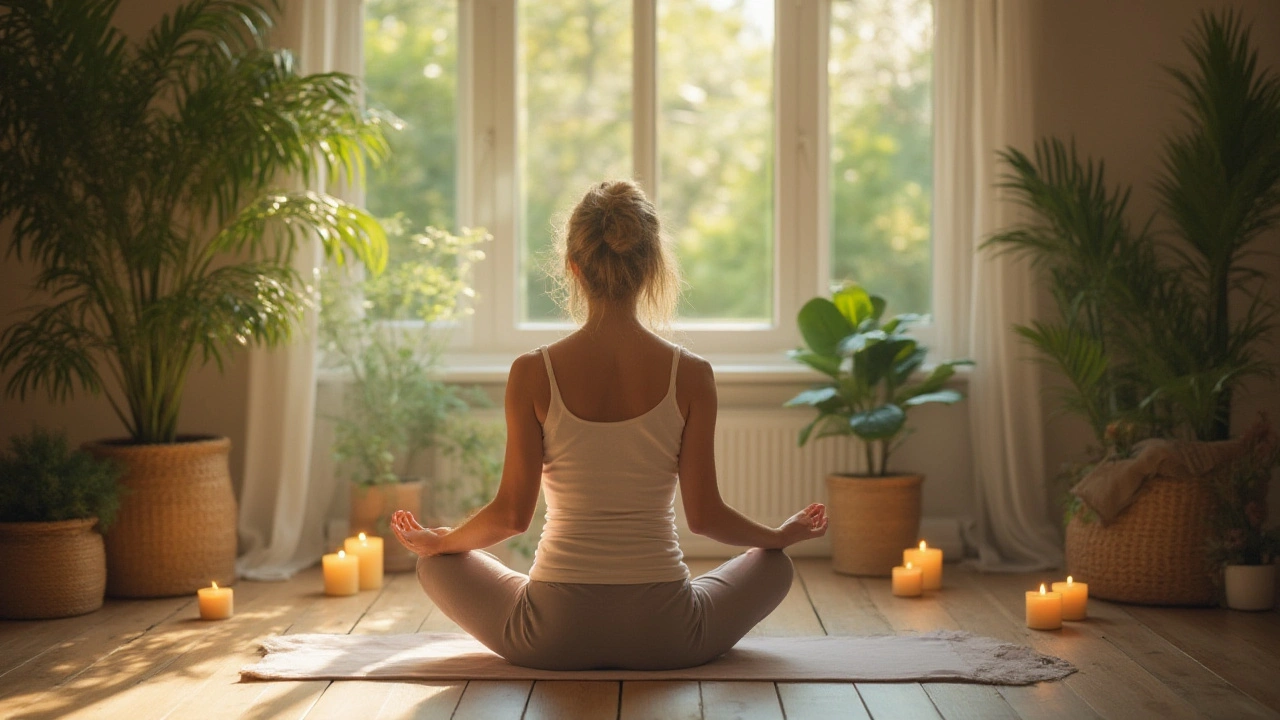Ever wish boosting your immune system could feel as good as a massage? Good news—you might be onto something! Science is starting to show that body massage can help your body defend itself against germs and stress, leaving you feeling stronger and more balanced.
If you've only thought of massages as a way to relax sore muscles or treat yourself after a long week, there’s way more going on beneath the surface. Researchers have found that regular massage can lower stress hormones, improve your sleep, and even help immune cells do their job better.
Wondering how this works? It’s not about fancy oils or magical hands. When your body relaxes, your stress levels drop, and that gives your immune system a real chance to get back on track. Think of it as a recharge for your internal batteries—no high-tech gear or complicated routines required.
If your goal is to stay healthy, especially during cold and flu season, adding a massage to your wellness routine could give you a gentle but powerful edge. Stick around, and I’ll break down exactly how it happens and how you can make it work for your lifestyle. Let’s get practical about touch and health.
- Key Points
- What Is Body Massage and Why Does It Matter?
- How Massage Impacts Your Immune System
- Types of Body Massage That Support Wellness
- What to Expect Before, During, and After Your Massage
- Practical Tips for Making the Most of Massage
Key Points
Here’s what’s really going on when you combine body massage with your health routine. No fluff—just straight facts you can use right away.
- Research from Cedars-Sinai Medical Center showed that people who received a 45-minute Swedish massage had higher white blood cell counts, which help fight off germs.
- Massage can lower the stress hormone cortisol by 30% or more, letting your immune system jump back into gear instead of fighting constant stress.
- Increased blood flow during massage means more oxygen and nutrients reach your immune cells, so they can respond faster to threats.
- Good sleep is key for immunity, and regular massage has been linked to falling asleep faster and staying asleep longer.
- If you have chronic pain or conditions like fibromyalgia, studies suggest massage may reduce flare-ups, which can otherwise put extra strain on your immune system.
- Different massage styles, like deep tissue and lymphatic drainage, offer unique immune-boosting benefits. It’s not one-size-fits-all, so you can pick what fits you best.
| Benefit | How Massage Helps | Typical Change |
|---|---|---|
| White Blood Cell Count | Stimulates immune cell production | Up to 20% increase (after one session) |
| Stress Hormone Levels | Reduces cortisol | About 30% drop |
| Sleep Quality | Promotes deeper sleep cycles | Faster sleep onset and fewer wakings |
| Pain and Inflammation | Relieves muscles and lowers chronic inflammation | Noticeable relief after just a few sessions |
The big takeaway? You’re not just getting a relaxing treat—massage can play a smart, measurable role in keeping your immune system and your mood in good shape.
What Is Body Massage and Why Does It Matter?
Body massage isn’t just about feeling good for an hour. At its core, it’s the practice of using hands, elbows, or special tools to work your muscles and soft tissues. This can range from light, relaxing strokes to deeper, more focused pressure that works out stubborn knots.
The goal? To help you unwind, reduce pain, loosen up tight spots, and, surprisingly, give your immune system a bit of a lift. Plenty of research shows that regular massage goes way beyond relaxation. It can ease tension headaches, boost your mood, and even help your body recover faster after workouts. Still, the big surprise for most people is how it impacts things like circulation and those tiny immune cells that fight off colds.
Here’s why it matters: everyday life is full of stress, and stress builds up in our bodies. When that happens, it can mess with your sleep, digestion, and make your immune system weaker. By making massage part of your routine, you’re not just treating yourself. You’re actively helping your body handle stress and recover better. This isn’t just a luxury; it’s something you can do to help your overall health in a real, noticeable way.
Whether you’re dealing with sore muscles from sitting at a desk, training for a 10K, or just trying to keep up with daily life, body massage offers a way to give back to your body. It’s simple, doesn’t require a prescription, and the benefits can add up. That’s why more people—including doctors and health coaches—now recommend it as a legit part of a healthy lifestyle.
How Massage Impacts Your Immune System
Let’s get straight to what’s happening inside your body when you get a body massage. You know that great feeling of deep relaxation? That’s actually your nervous system shifting gears, dialing back on its stress mode—what doctors call “fight or flight”—and kicking into “rest and digest.” That’s a win for your immune system.
Here’s what’s extra cool: one study published in the Journal of Alternative and Complementary Medicine found that people who got a 45-minute Swedish massage had way lower levels of cortisol (the stress hormone) and a boost in white blood cells, especially natural killer cells. These cells are basically your body’s security team, spotting and fighting off viruses and even cancer cells.
Massages also increase blood flow, which helps immune cells get to where they’re needed faster. Imagine a busy city street at rush hour—if traffic’s moving, people get to work on time. Massage helps clear out those traffic jams in your circulation so your immunity team isn’t stuck in traffic.
Another bonus: the act of touch itself prompts your body to make more serotonin, the feel-good chemical. And guess what? When you feel good, you’re more likely to sleep better, eat properly, and keep stress in check—all things that control how well your immune system works.
If you want to see how these benefits compare between folks who get massages and those who don’t, check out this quick table:
| Group | White Blood Cell Increase | Cortisol Level (decrease) | Reported Well-being |
|---|---|---|---|
| Massage Participants | +20% | -30% | Much Improved |
| No Massage | ~0% | ~0% | No Change |
So, not only does regular massage help you relax, it’s actually helping your immune system react faster and stronger. If you’re looking to stay healthy, those massage sessions are doing more behind the scenes than you think.

Types of Body Massage That Support Wellness
When it comes to supporting your health, not all massages are the same. Different styles offer different perks for your body and mind. Let’s break down some top options that have been shown to boost immune health and help you feel your best.
Swedish massage is probably the one most people think of first. It uses long, gentle strokes and kneading. Great for relaxing, and studies show it can lower stress hormones like cortisol. In one small study from Cedars-Sinai, people getting 45-minute Swedish massages had higher counts of lymphocytes—these are white blood cells that help your body fight sickness.
Deep tissue massage goes further, reaching into stubborn knots and tight spots. It’s perfect if you’ve got muscle pain, but it also helps your immune system by improving circulation and flushing out waste from your tissues.
If you’re dealing with allergies, breathing issues, or are just plain run-down, lymphatic drainage massage is worth a look. This style is super gentle and aims to move fluid through your lymphatic system—that’s the network that helps filter out toxins. Some people report fewer colds and quicker recovery after adding this to their routine.
Let’s talk about a popular option for folks who want relaxation without all the deep digging: aromatherapy massage. Here, massage therapists use essential oils like eucalyptus or lavender. While the science on oils is still mixed, they can make your session feel more calming. Bonus: feeling calmer equals less stress on your immune system.
“Massage doesn’t just feel good—it actually produces measurable changes in the immune system,” says Dr. Mark Rapaport, Chair of Psychiatry at Emory University, referencing his well-known Cedars-Sinai study on massage and immunity.
Not sure which style to try? Here’s a quick look at how some of the most common massages stack up for wellness:
| Type Of Massage | Main Benefit | Best For |
|---|---|---|
| Swedish Massage | Reduces stress | Anyone needing relaxation |
| Deep Tissue Massage | Relieves muscle tension | Active people, chronic pain |
| Lymphatic Drainage | Boosts lymph flow, detox | Low immunity, swelling |
| Aromatherapy | Enhances relaxation | Stress, mood support |
Picking the right massage isn’t about fancy names—it’s about what your body needs. Ask your therapist to help you choose or try a few styles to see how you feel afterward. Each offers a direct way to support your body’s natural defenses and keep you feeling well.
What to Expect Before, During, and After Your Massage
So you’ve decided to try a body massage with hopes of feeling better and maybe even strengthening your immune system. What now? Here’s exactly what the experience looks like from start to finish—no surprises.
Before Your Massage
- You'll probably fill out a quick health form. This just helps your massage therapist know about any allergies, injuries, or health conditions you might have.
- It’s a good idea to drink some water before you go. Hydrated muscles respond better to massage, and it makes the whole thing more comfortable.
- Avoid eating a big meal right before you arrive. A light snack is fine, but lying down with a full stomach can feel awkward.
- Wear something comfortable and easy to change in and out of. Most places provide a robe or towel, but you’ll want to feel relaxed while you’re there and after.
During Your Massage
- You’ll get to choose areas to focus on—like your back, shoulders, or even your feet. Don’t be shy about speaking up if you want more or less pressure. Therapists expect it, and your comfort matters most.
- Most massages take place on a padded table in a private, calm room. Some places play soft music, but if you find it distracting, just ask them to turn it off or adjust the volume.
- If you’re not sure what to do with your arms or legs, just relax—your therapist will guide you. And remember, you’re only expected to undress to your comfort level. If you want to keep any clothes on, just say so.
- Sometimes you’ll be asked to flip over or adjust your position. This is totally normal and part of getting to all those tight spots.
After Your Massage
- Drink plenty of water to help flush out any waste your muscles have released. This really helps keep soreness to a minimum.
- Take your time getting up. It’s common to feel a little lightheaded as your body adjusts.
- You might be a bit sore for a day or so, kind of like you went to the gym. That’s usually a sign your muscles are relaxing and releasing tension.
- If anything feels too uncomfortable later, don’t hesitate to call your massage therapist. They can offer advice or suggest ways to recover faster.
That’s it! No magic, just a step-by-step path to feeling better and maybe giving your immune system the boost it needs. The more often you go, the more natural—and beneficial—it feels.
Practical Tips for Making the Most of Massage
To get real benefits for your immune system, you can't treat a massage like a rare treat or a last-minute stress fix. Treat it like any other body massage plan—regular, smart, and informed. Here's what really moves the needle:
- Be Consistent: According to a study published by the Journal of Alternative and Complementary Medicine, people who got a 45-minute massage once a week for five weeks showed noticeable boosts in lymphocyte count (that’s a type of white blood cell that helps fight off illnesses). So, don't just go once a year—regular appointments matter.
- Find the Right Therapist: Not all massage therapists are created equal. Look for someone certified, ideally with health-focused experience. A good therapist will tailor their approach if you mention your immune health as a goal.
- Hydrate, Hydrate, Hydrate: Massage helps move fluids through your body. Drink water after your session so your system can flush out toxins and keep everything balanced.
- Be Upfront About Your Health: Always mention allergies, chronic conditions, and current medications before your session. Therapists need to know if you have any immune issues so they can adjust pressure or techniques.
- Pair Massage With Healthy Habits: Massage isn’t magic. It works best if you also get good sleep, eat nutritious foods, manage stress, and exercise a bit. Think of it as one tool in your wellness toolkit.
“Research shows massage can lower levels of cortisol and increase activity of natural killer cells, which are essential players in the immune response.” — Dr. Mark Rapaport, Emory University School of Medicine
Quick glance at what might happen after a consistent massage routine:
| Benefit | How Fast You Might Notice | What It Means |
|---|---|---|
| Lower Stress Hormones | After 1-2 sessions | Could mean fewer sick days and better mood |
| Improved Immune Markers | After 4-5 weeks of regular massage | Better defense against common colds |
| Better Sleep | Within 2 weeks | Deeper sleep helps your body recover |
If you want to test out what works best for you, try different massage types—Swedish, deep tissue, or even lymphatic drainage. Keep a note of how you feel after each session. Some people feel energized, others get super sleepy. That’s totally normal.
Last tip: Don’t treat pain as a badge of honor. Massage should never hurt. Speak up if something feels off so your therapist can adjust. You get the most benefit when you actually enjoy the experience.




